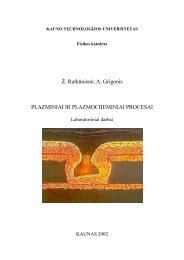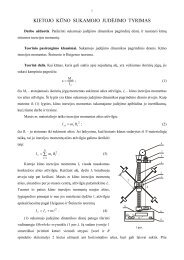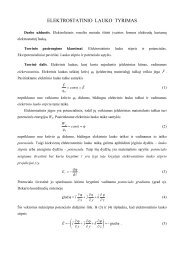PROCEEDINGS OF THE 7 INTERNATIONAL ... - Fizika
PROCEEDINGS OF THE 7 INTERNATIONAL ... - Fizika
PROCEEDINGS OF THE 7 INTERNATIONAL ... - Fizika
Create successful ePaper yourself
Turn your PDF publications into a flip-book with our unique Google optimized e-Paper software.
M. Pučetaitė et al. / Medical Physics in the Baltic States 7 (2009) 96 - 99<br />
reflection technique exhibit absorptions resembling the<br />
first-derivative of a conventional absorption spectrum.<br />
The bands of such spectra are called restrahlen bands<br />
and their intensity grows proportionally to the<br />
absorption.<br />
For the first time in this work it is shown that there can<br />
be two types of mixed calcium oxalate and calcium<br />
phosphate stones. The stones of the first type do not<br />
have any domain structure, while the stones of the<br />
second type have one domain of calcium phosphate<br />
located close to the edge of the stone surrounded by<br />
calcium oxalate. This finding brings to conclusion that<br />
the stones with calcium oxalate as a main component<br />
can be formed in two ways: (I) loose calcium oxalate<br />
stone grows in urinary system from oversaturated salt<br />
solution without fixation to the walls of the system (II)<br />
calcium oxalate stone, which was initiated on the<br />
walls. In this case the grow starts from formation of<br />
calcium phosphate crystal on the wall of the system.<br />
Later this crystal is covered by calcium oxalate.<br />
We believe, that having larger set of calcium<br />
oxalate/calcium phosphate mixed stones we will be<br />
able to clarify if covering of calcium phosphate crystal<br />
by calcium oxalate takes place on the walls of urinary<br />
system, or the process starts when calcium phosphate<br />
for some reason (naturally, with aid of medicines or<br />
ultrasound treatment) will become loose. Such studies<br />
are now underway in our laboratory<br />
99<br />
5.References<br />
1. Laurence Estepa, Michel Daudon. Contribution of<br />
Fourier Transform Infrared Spectroscopy to the<br />
Identification of Urinary Stones and Kidney<br />
Crystal Deposits. John Wiley & Sons, Inc.<br />
Biospectroscopy 3, 1997. p. 347-369.<br />
2. Jennifer C. Anderson, James C. Williams Jr.,<br />
Andrew P. Evan, Keith W. Condon, Andre J.<br />
Sommer. Analysis of Urinary Calculi Using an<br />
Infrared Microspectroscopic Surface Reflectance<br />
Imaging Technique. Urol Res., 35, 2007. p. 41-48.<br />
3. C. Paluszkiewicz, M. Galka, W. Kwiatek, A.<br />
Parczewski, S. Walas. Renal Stone Studies Using<br />
Vibrational Spectroscopy and Trace Element<br />
Analysis. John Wiley & Sons, Inc.<br />
Biospectroscopy 3, 1997. p. 403-407.<br />
4. Iqbal Singh. Renal Geology (Quantitative Renal<br />
Stone Analysis) by ‘Fourier Transform Infrared<br />
Spectroscopy’. Int Urol Nephrol, 40, 2008. p. 595-<br />
602.<br />
5. V. Hendrixson, V. Šablinskas, D. Leščiūtė, A.<br />
Želvys, F. Jankevičius, Z. Kučinskienė. Infrared<br />
spectroscoplcal approach in kidney stones research<br />
// Laboratorinė medicina. t. 10, nr. 2, 2008. p. 99-<br />
105.








